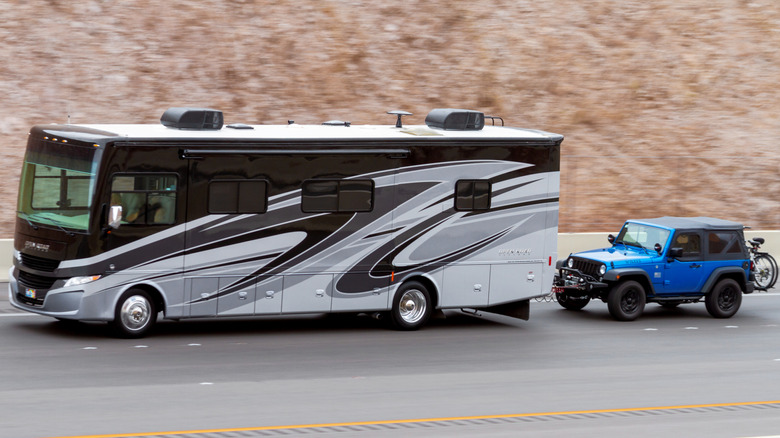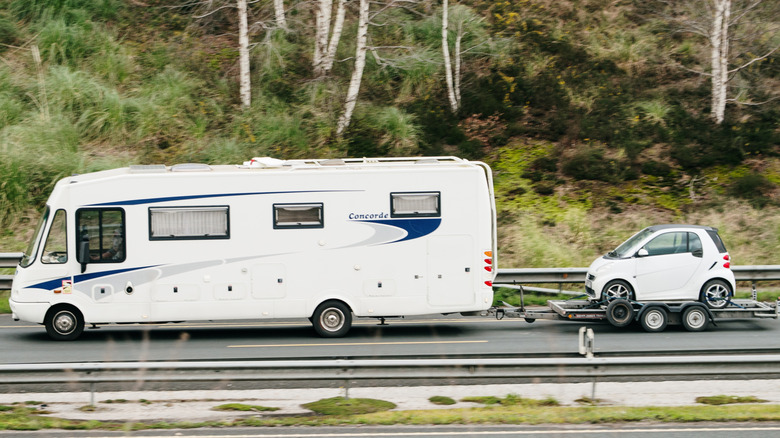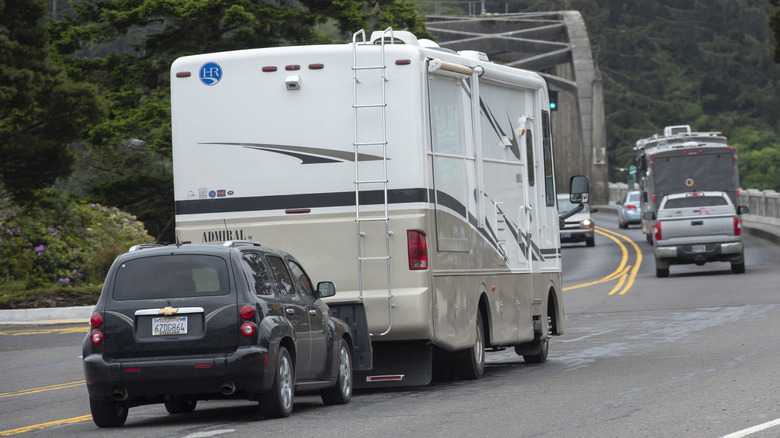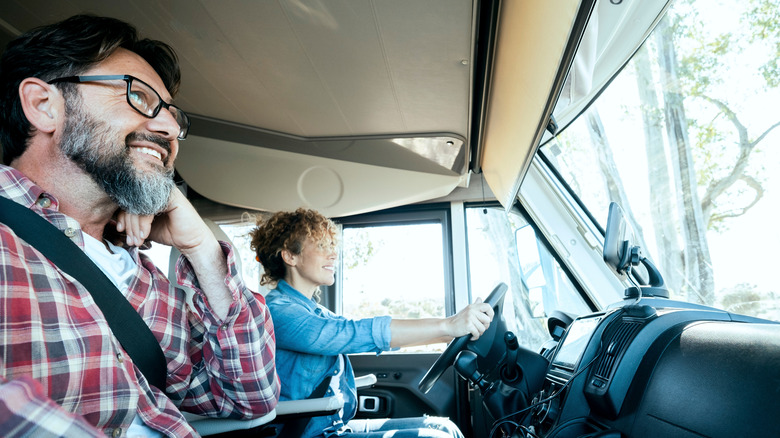
Today's RVs and motorhomes can go to insane lengths to provide you with all the luxuries of home while you're out on the road. But what happens if you get to your destination and want to do more than just lounge around, even if you've got a huge luxury RV for millionaires?
For a lot of folks, that means towing a car along behind their motorhomes. That way, they can leave their mobile mansions behind for a more convenient drive into town, sightseeing, or other adventures. It does provide some challenges,
however, and there's much to know before you try to tow.
The most important is knowing whether your RV is capable of towing another vehicle in the first place. Remember, the average weight of today's cars tops 4,000 pounds, and that's a significant amount of extra mass for a vehicle that's already pulling around its own weight of up to 30,000 pounds or more (the upper range of the average weight of a Class A motorhome).
With that in mind, the very first thing you need to know about towing a car with your RV is whether the latter is rated for towing in the first place. The good news is that it's as easy as looking in your RV's owner manual. Let's see what else you need to keep in mind before hooking up a car to your home away from home.
Read more: These Are The Car-Related Movie Mistakes That Really Bother You
Things To Know About Flat Towing

There are three main methods of towing a car behind an RV or motorhome, and you should know the ins and outs of each before deciding which you use. The most basic is called dinghy towing, or flat towing, and that's when you directly hitch a car to your motorhome, with the car's wheels remaining right on the road and the transmission in neutral. But not all cars can be towed that way, so you'll have to check the owner's manual for the vehicle you're considering pulling — and follow all guidelines for safety.
Perhaps the first might be that you shouldn't attempt to flat tow a vehicle backward. In addition, you'll need to know what equipment is needed. Beyond the hitch and wiring connector necessary for just about any towing job, flat towing requires a tow bar to attach behind the RV, a baseplate to connect the tow bar to the car being towed, safety cables in case the main connection between vehicles fails, and a supplemental braking system to help the towed car stop. And you'll also need some $1,500 to $2,500 to pay for that stuff.
Things To Know About Using A Tow Dolly Or Trailer

We'll discuss this more below, but sometimes an RV can pull the weight of a car plus the weight of a trailer, and sometimes it can't. In the latter situation, you can opt for a tow dolly, which lifts the car's front wheels off the ground and leaves the back rubber on the road. This is primarily for front-wheel-drive cars, as is flat towing, and while you don't need to worry about a base plate or tow bar, you do need to either buy or rent the dolly. In many states, you need to get a license for it, too.
A trailer is the best way to pull a four- or all-wheel-drive car behind your RV. Not only does it protect the car's drivetrain, but — unlike with flat or dolly towing — it allows you to reverse the RV with the car still attached. (FYI: Here is the easiest way to back up a trailer.) Easy to rent as well, trailers may still require ramps for loading up your vehicle, ratchet straps to secure it, and a separate brake controller that can be standard equipment on some RVs.
Things To Know About The Weight You Can Tow

Your RV's maximum tow rating is the amount of weight that can be pulled behind it, including a trailer or trailer dolly, the weight of the car being towed, and anything else in the car, like fuel or extra luggage, or on the trailer. However, you also have to take into account your RV's gross vehicle weight rating (GVWR), which is easy to find with our quick guide for RV owners. The short story is that it measures how much weight the vehicle itself can carry — not pull.
This is where it gets tricky, because there's a separate limit of what a vehicle can both tow and carry known as gross combined weight rating (GCWR). But GCWR does not equal GVWR plus maximum tow rating. It's more like you have to subtract GVWR from GCWR. The remainder is your towing capacity, and that can be lower than your towing maximum. So if your RV is carrying so many people and so much gear that it's right up to its limit for GVWR, there may not be enough GCWR left over to handle a full trailer.
Things To Know About Driving An RV While Towing

Driving an RV can be a challenge even when you're not towing, and when you are, that adds yet another degree of difficulty. With that in mind, here are a few quick tips.
Right off the bat, you may need a special license to drive your RV. You're good in most states if your RV is less than 26,000 pounds, but it makes sense to check first. It also makes sense to get some practice in, whether it's by taking your vehicle to an empty parking lot or taking an RV driver's ed class.
All that extra weight makes a definite difference in driving dynamics out on the road, too, so go slow. It's going to take you longer to get up to speed or stop in an RV, so you have to be thinking ahead. Speaking of thinking ahead, you should plan out your route, including gas stops, in advance to avoid possible road restrictions. Check your destination as well, particularly if you have an older recreational vehicle. You might love your vintage RV, but it may be banned from certain campsites.
Want more like this? Join the Jalopnik newsletter to get the latest auto news sent straight to your inbox...
Read the original article on Jalopnik.










